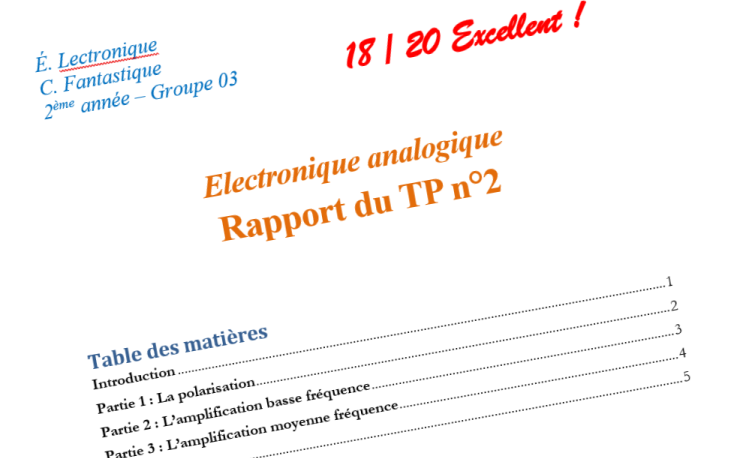Accueil » Tous les articles » Techniques & méthodologies »
En synthèse
Demandez-vous : quelles informations je souhaiterais avoir si vous aviez à reprendre ce travail en contexte stressant ?
3 grandes parties classiques dans un rapport de TP : l’introduction (qui précise le contexte et l’objet du rapport) ; le développement (qui reprend les grandes étapes et commente les résultats) ; la conclusion (qui synthétise le travail et prend du recul).
What to write in your report?
Imagine: you’re called by your boss to work in a quality crisis cell. The work was done years ago by a person who is no longer with your company, so you have to learn what’s been done just by reading the reports.
What would you like to find in it? Just the same as what your teacher would like to find in your reports 😉!
Introduction: What is it all about?
The introduction should contain at least 3 parts:
- The context: In which situation are you doing this report (which course, which part, etc.)?
- Usefulness: Why are you writing this report (well, because you were asked to, but there should be a reason why you were asked 😉)? What’s the goal, what should you learn, what’s the point, what’s the usefulness?
- The plan: What are the significant parts of your report? These parts should show a path and a logical progression.
If you were reading while in a cell crisis, you would like to see here: what will I learn? At which stage, in the project, was this written? Is it useful for my problem?
The main part: what you’ve done, what you’ve understood, what you think
The main part should make explicit the evolution in your thinking/understanding. This is as a LEGO assembly, where each part has its usefulness and adds a little to the previous stage.
You need to be clear, explicit and highlight the most important parts. Show the information so that the test can be done once again using just your indications (initial conditions, settings, protocol,…). And, most importantly, add your own commentaries to the results: this is your real added value, this is awaited from you! At last, write the problems you faced, and the solutions you (hopefully) found.
If you add illustrations (which you probably will), remember to always add a title, and legends, scales and units to each axis.
If you were reading while in a cell crisis, you would like to see here: what has been made? What are the results and related comments? What problems were met and what solutions were given?
Conclusion: take a step back
The conclusion is the report’s synthesis: first, remind the work you’ve done, the fundamental lessons you got. The key is to give only the most important things, without forgetting one (ask yourself: if I had just 30 seconds to remind myself of this work before doing it for a test, what should I remind?).
Next, write the limits of the practical work you’ve done. This can be oversimplification, component’s or measurement tools’ tolerance, the hypothesis or anything else that one should have in mind at the end.
At last, tell what could be the next step / open your work to a wider perspective.
If you were reading while in a cell crisis, you would like to see here: what main should we remind from that? Is it enough or should the work be completed by something else?
Last but not least: check your grammar!
If your report is excellent but has spelling mistakes on each sentence, you make your reader’s work painful… Check your grammar, check your spelling, you will give your report a much higher value!
Today, there are very good (free) checkers available: Word, LanguageTool, ProWritingAid among others. Use them!
La mindmap
Lien : https://app.wisemapping.com/c/maps/1377739/public
En savoir plus sur Etudier et Réussir !
Subscribe to get the latest posts sent to your email.

Hello! I simply would like to offer you a huge thumbs up for the great information you have right here on this post. I will be coming back to your blog for more soon.
Thanks 🙂
[edited] What an insightful article! Your ability to break down complex topics into easily understandable points is truly commendable. I appreciate the thorough research and the engaging writing style that keeps readers hooked from start to finish. Thank you for sharing your knowledge and providing such valuable content. I look forward to reading more of your work in the future!
Thanks 👍
Fantastic article! I appreciate how clearly you explained the topic. Your insights are both informative and thought-provoking. I’m curious about your thoughts on the future implications of this. How do you see this evolving over time? Looking forward to more discussions and perspectives from others. Thanks for sharing!
Thanks 👍
[Edited] Great article! I found your perspective on this topic both enlightening and thought-provoking. The way you break down complex ideas into understandable insights is truly commendable. It’s interesting to see how these developments could shape our future. I’m particularly intrigued by your point about potential challenges and would love to dive deeper into that.
Looking forward to hearing others’ thoughts and continuing this discussion. Thanks for sharing such valuable information!
Thanks 👍